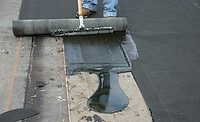Measuring the ROEE of Sustainable Roof Insulation




Given today’s low energy prices, driven in part by excess supplies of oil and natural gas, it’s become a little more difficult to sell the value of high-R roof insulation based solely on traditional Return on Investment, or ROI. You can find a variety of studies that have examined the cost of additional roof insulation versus the hard dollar payback, and the current savings are far from wildly impressive. A recent NRCA study placed the payback period for roofing insulation anywhere from four years to well over 30 years, and my own past research tends to fall in the range of five to 25, depending on climate, code requirements and other factors.
However, for the building owner interested in long-term environmental sustainability and economic return, there is a new measure that can help provide some additional perspective on the value of highly efficient roof insulation systems. I call the concept Return on Embodied Energy, or ROEE.
Embodied energy is the total amount of energy required to manufacture and install a product such as roof insulation. This includes all the energy required to extract the raw materials and transport them to the factory, as well as manufacturing, packaging and delivering the insulation to a jobsite. The unloading and installing is also taken into consideration, as is the eventual removal and disposal. As you can imagine, it takes a lot of time and effort to make such a complicated calculation.
To provide a comprehensive scorecard of the total energy used to produce a specific unit of a product, many insulation manufacturers use Environmental Product Disclosures (EPDs). The information is available publically as part of a new product-disclosure tool. In the case of roofing insulation, the unit is related to the R-value the product provides. This means that it’s possible to compare the total amount of energy required to manufacture and install any insulation product against the estimated energy savings it can provide. As a result, you can compare the amount of embodied energy by the amount of saved energy to calculate your return on the energy “investment” of the insulation.
EPDs are now published for a wide variety of roof insulation products, including spray polyurethane foam (SPF), polyisocyanurate, heavy density mineral wool board and extruded polystyrene (XPS). Several of these EPDs include an analysis comparing the embodied energy identified in the EPD against the amount of energy that the product will save over time. The results of this approach are very different from traditional ROI calculations.
One of these EPDs, published by a manufacturer of XPS, calculates that the ROEE or payback period to break even on the embodied energy is as little as eight months to slightly more than a year. A similar EPD published by the Spray Polyurethane Foam Alliance (SPFA) arrives at a similar payback period of one to two years. An EPD published by the Polyisocyanurate Insulation Manufacturers Association (PIMA) calculates the energy payback to be 47 times the original embodied energy over a 60-year service life, which amounts to a net payback period of less than a year and a half.
Although each study used different assumptions and it would not be meaningful to compare among them, their combined findings of an ROEE payback in less than two years is certainly a lot different than the much longer payback periods obtained using traditional economic ROI analysis. So when you have a chance, ask your roofing insulation supplier if they have a published EPD for their product. This will allow you to see how much energy your can save for your customers as compared to the energy it takes to provide and install their roof insulation.
For more information about EPDs and their impact on product selection, please take a look at my article, “Disclosure: The Newest Dimension in Green Building,” published in last March’s issue of Roofing Contractor.
Looking for a reprint of this article?
From high-res PDFs to custom plaques, order your copy today!








